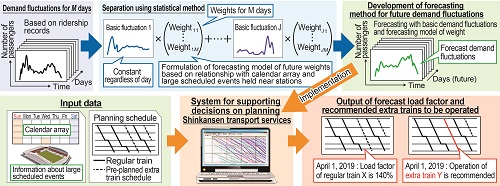24. Method for supporting decisions on planning Shinkansen transport services based on forecast demand fluctuations
In order to formulate Shinkansen transport planning with high passengers’ convenience, it is necessary to accurately forecast Shinkansen demand which constantly fluctuate. However, it was difficult to forecast such detailed passenger demand with conventional approach because it targets demand of average day.
Consequently, a method to forecast half-hourly fluctuations in Shinkansen passenger demand was developed using actual ridership records, calendar arrays, and information about scheduled large local events (Fig. 1).
First of all, daily demand fluctuations were calculated from collected ridership records. Using a statistical method, these fluctuations were separated into several ‘basic fluctuations’ which were constant regardless of day, and ‘weights’ of each basic fluctuations were estimated. Then, based on the relationship between the weights, calendar arrays and information about large scheduled events, an equation was formulated to forecast future weights. By combining forecast weights with the basic fluctuations, future daily demand fluctuations were forecast. Comparison of forecast results with actual data, confirmed a high level of accuracy (correlation coefficient of over 0.8) for over 90% of the examined period of 172 days (Fig. 2).
The developed Shinkansen transport planning support system which incorporates the demand forecasting method can be used to calculate the load factor between all stations along the route of all scheduled trains, based on the forecast demand fluctuations. By using this system, it is therefore possible to determine whether pre-planned extra trains need to be operated.
Other Contents
- 21. Active bogie angle steering system ensuring both running stability and reduced lateral force
- 22. Improvement of the effectiveness of tunnel entrance hoods by enlargement of their cross-sectional area to reduce micro-pressure waves
- 23. Communication network and train operation simulator for designing train control system using radio communication
- 24. Method for supporting decisions on planning Shinkansen transport services based on forecast demand fluctuations
- 21. Active bogie angle steering system ensuring both running stability and reduced lateral force
- 22. Improvement of the effectiveness of tunnel entrance hoods by enlargement of their cross-sectional area to reduce micro-pressure waves
- 23. Communication network and train operation simulator for designing train control system using radio communication
- 24. Method for supporting decisions on planning Shinkansen transport services based on forecast demand fluctuations


